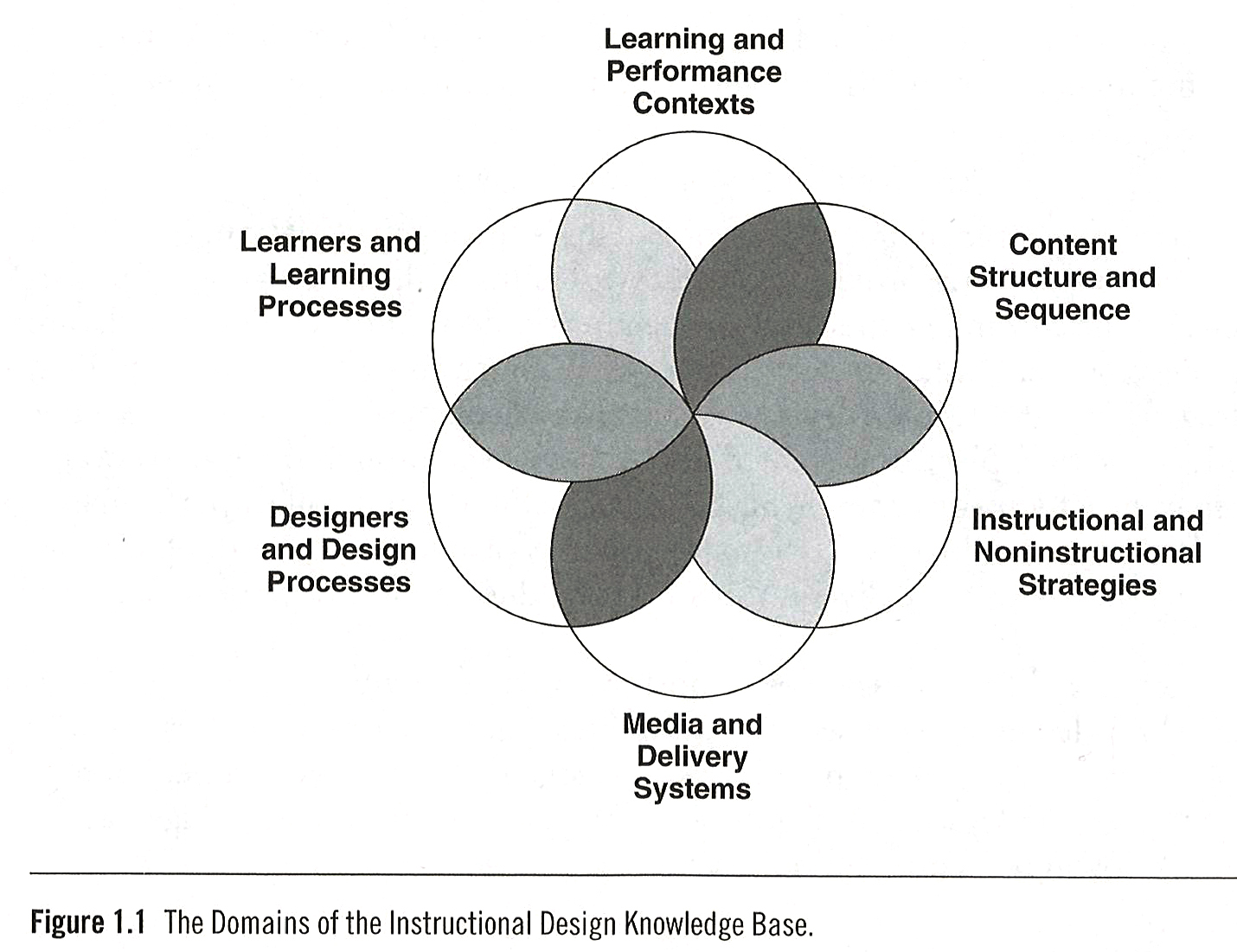Instructional Design
Table of Contents
- Introduction
- The Six Domains of the
Instructional Design Knowledge Base
- Instructional Design Theory
(Descriptive)
- Components an
Instructional Design Theory Should Include
- Constructs about the
Nature of Instructional Design Theory
-
Instructional Design Models (Prescriptive)
- ADDIE
- 4C/ID
Introduction
Instructional design is the process of combining
descriptive and prescriptive theories in an effort to
develop instructional products which are effective, efficient, and
engaging.
Instruction (however you conceive it) can be discussed in terms of factors such as
context (for example, corporate, government, military, college, and K–12),
domain (for example, science, education, and mathematics),
environment (for example, face-to-face, online, virtual, and simulation), and
culture (for example, country, religion, and location).
(Bruner, Capella, ED7420, Unit 1, Introduction).
"Instructional design (ID) today is an established
profession, as well as an area of study. As a profession, it
consists of a series of well-defined competencies, and an
active group of practitioners who work in increasingly
complex and sophisticated environments. As an area of study,
it has a rich and growing foundation of research and theory
viewed from increasingly diverse points of view. Both the
practice and the study of ID can be seen in two ways: as
strategies for creating particular products and as the
implementation and management of the overall design process.
In either of these orientations ID is a planning process. As
such, distinguished from development processes, the actual
production of instructional materials" (Richey, Klein, &
Tracey, 2011).
"Instructional design synthesizes elements from a number of related disciplines, such as communication, psychology,
curriculum development, and computer-assisted instruction
[CAI]" Ledford & Sleeman, 2000, p. 20). In addition to
the influence from these disciplines, instructional design
is also influenced by many other theories including communication
theory, systems theory, learning theory, design theory, and
instructional theory (Smith & Ragan, 2005, p. 33, fig. 2.4).
Contributions to instructional design can be organized
into two groupings descriptive and prescriptive.
Instructional design theory is the descriptive grouping and
instructional design models make up the prescriptive
offerings.
Six Domains of the Instructional
Design Knowledge Base
 (Richey, Klein, & Tracey, 2011, p. 4).
(Richey, Klein, & Tracey, 2011, p. 4).
Instructional design as a discipline makes informed
decisions based on various theories and models (Richey,
Klein, & Tracey, 201, p. 4).
Instructional Design Theory
Instructional design theories abound, but Merrill (2009)
feels that the all have general principles in common and
wrote a paper about it titled the First Principles of
Instruction.
Due the confusion caused by a non-precise usage of the
instructional design theory vocabulary and an observed
disagreement within the instructional design research
community Reigeluth & Carr-Chellman (2009) proposed a
ADDIE-like version of how to organize instructional design
theory as a way to synthesize previous instructional design
models into one common framework. The components they suggested
should be included in an instructional design theory and a description of the
component's task are shown in the table below.
Components an Instructional Design
Theory Should Include
|
Component Name |
Component Task |
| event |
Describing what the instruction should
be like |
| analysis |
Gathering
Information for making decisions |
| planning |
Creating the
instructional plans |
| building |
Creating instructional
resources |
| implementation |
Preparing for
implementation |
| evaluation |
Evaluating the instruction |
(Reigeluth, 2009, p. 8)
Figure 1 below represents an adaptation of the Reigeluth &
Carr-Chellman model; it has been abbreviated in order to
accentuate the titles of each of the six components. In
order to accurately represent Reigeluth & Carr-Chellman's
model, the reader should read each component as the
instructional (component name) design theory; e.g.
instructional event design theory, instructional analysis
design theory, etc. Figure 1.
Figure 1.
Constructs About the Nature of
Instructional Design Theory
All elements of any instructional theory can be
categorized as one or the other of these two constructs.
- Instructional method
- Scope of a method (a continuum from micro
through meso to macro)
- Generality of a method (a continuum from
universal to local)
- Precision of a method ( a continuum from highly
precise to highly imprecise)
- Parts of a method (categories that are more
precise)
- Kinds of a method (categories that are more
precise)
- Criteria for a method (categories that are
more precise)
- Power of a method (a continuum from low to high)
- Consistency of a method ( a continuum from
low to high)
- Instructional situation
- Values (categories)
- Values about learning goals
- Values about priorities
- Values about methods
- Values about who has power
- Conditions (categories)
- Content
- Leaner
- Learning environment
- Instructional development constraints
(Reigeluth & Carr-Chellman, 2009, pp. 21-24)
Instructional Design Models
Many models for developing instruction exist including
ADDIE (ISD), 4C/ID (ID),
ADDIE
One of the
more popular ID models is ADDIE which is an acronym for the
five steps which it comprises,
Analysis, Design, Development, Implementation,
and Evaluation. For the most part these steps can be
applied in a linear (waterfall) fashion, however newer
iterations stress that that
the entire process is cyclical in that even after the
instruction is implemented it should be analyzed for
redesign, redevelopment or re-implementation when a new or
altered instructional need is determined to exist. Also,
evaluation should occur at each of the first four steps of
the process. In order for the instructional methodology at
each step to properly be evaluated, a specific instrument of
evaluation should be created and applied for each step in
the process.
4C/ID
van Merriënboer (2002) developed the four component
instructional design model to address what he felt were
limitations in previous offerings by other ID models.
 Figure 2 - The 4C/ID instructional model (van Merriënboer, 2002).
Figure 2 - The 4C/ID instructional model (van Merriënboer, 2002).